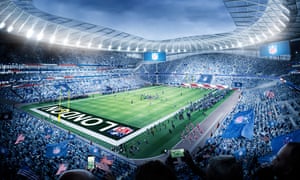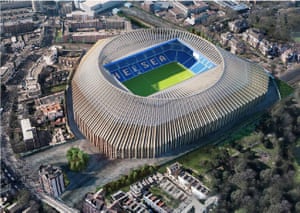With its personal devoted fromagerie, microbrewery and Michelin-calibre restaurant, it may be simple to neglect you could have come to observe the soccer when you’re reclining in one of many premium lounges of Tottenham Hotspur’s new £750m stadium. The 61,000-seat behemoth will function the longest bar within the nation, heated seats with built-in USB ports, a glass-walled tunnel so you possibly can see the gamers earlier than the sport and even a “sky walk” permitting followers to clamber over the roof of the world.
“It would be the most technically superior stadium on the earth,” says Christopher Lee, an architect with Populous, the sports activities and leisure big behind the design of the new-look White Hart Lane. “It has to provide a reason for people to get off their sofas and leave their 50-inch flatscreen TVs.”
As residence leisure methods grow to be ever extra elaborate, permitting followers to observe the motion from each conceivable angle in ultra-high-definition, the standard soccer stadium is having to up its sport to lure folks from the consolation of their properties. The promise of a pie, a pint and singsong within the stands simply just isn’t sufficient.
“People expect more from the experience and they’re willing to pay for it,” says Lee. While premium seat tickets to Tottenham’s gargantuan silver spaceship will begin at £89, membership of its unique H Club – which comes with “provision for guests to store their personal vintage wines, cognacs and liquors in a purpose-built, temperature-controlled on-site reserve” – will value £30,000 for 2. That’s the worth you need to pay for having fun with a plate of specifically sourced half-time cheese.
Besides the flamboyant catering, the soccer pitch itself has to work loads more durable, too. This is the primary discipline of its type designed to separate into three elements and slide seamlessly below the seating stands, revealing an astroturf discipline beneath for American soccer, positioned at a decrease degree to make sure good sight strains for each modes of play. Acoustic consultants had been introduced on board so as to assure most amplification of crowd noise, making certain a “wall of sound” will resonate from the 17,000-seat south stand, conceived as a single tier to rival the Kop at Anfield or the Yellow Wall at Borussia Dortmund’s Westfalenstadion.

vCard.red is a free platform for creating a mobile-friendly digital business cards. You can easily create a vCard and generate a QR code for it, allowing others to scan and save your contact details instantly.
The platform allows you to display contact information, social media links, services, and products all in one shareable link. Optional features include appointment scheduling, WhatsApp-based storefronts, media galleries, and custom design options.
So, having reached the apogee of transformable robotic pitches, unique wonderful eating suites and completely tuned seating, what subsequent for the way forward for stadiums?
Lee, who has labored on main sports activities venues around the globe, says know-how is having a big impact on how these buildings are being imagined. “Twenty years ago we put screens into stadiums,” he says. “But now we all carry a supercomputer in our pockets, so there are opportunities for layering the viewing experience – from seeing different camera angles in your seat, to tracking the heart rate, speed and impact of players wearing smart clothing on the pitch.”
He says the following huge frontier is holographic illustration, describing a world the place gamers may be beamed on to the sphere from 1000’s of miles away. “In the not-too-distant future you can imagine Real Madrid supporters in São Paulo watching the game in their stadium at the same time as the fans in Spain,” he says. “It’s all about coming together for the collective experience.”

It might sound far-fetched however the know-how is already right here. In its bid for the 2022 World Cup, Japan promised to report video games in 360 levels with 200 HD cameras and broadcast them around the globe stay in 3D, permitting gamers to seem in a whole bunch of stadiums concurrently as holographic projections. Microphones embedded under the pitch would have recorded each ball kick and deal with whimper, including to the sense of realism.
While Japan’s sci-fi dream misplaced out to the rippling vaginal imaginative and prescient of Qatar’s stadium plans, it’s American soccer within the US that’s now main the way in which in creating subsequent technology venues. Given the eye-watering sums generated from the sale of TV rights (with deals worth $27bn), every staff within the National Football League is desperately attempting to construct larger video screens and supply sooner in-seat wifi than the following, even when most followers won’t ever have the possibility to expertise it in individual. The new $1.6bn Atlanta Falcons stadium, at present below building and on account of open later this yr, will function the world’s first 360-degree video wall, working for 335m across the bowl, in addition to an unlimited a rotating oculus roof, impressed by the wings of a falcon, fabricated from eight 500-ton transferring items. At one level it was even going to incorporate vibrating seats.
“NFL has become an arms race,” says the architect John Rhodes of HOK, the agency behind the Atlanta undertaking. “It used to be about sheer size, but now everyone’s focused on the convergence of the physical and digital experience, increasing connectivity in the stadium to bring fans closer to the players.”
He says that parametric modelling methods are having an impact on the geometry of the seating bowl, too, the structure generated by a complete host of interconnected parameters, from acoustics to distance from the bar and proximity to the bench. He sees a future the place the seating bowl may be fragmented into smaller teams of 50-100 folks, creating “group suites” to accentuate the bodily and social interplay between followers, whereas drones will grow to be a ubiquitous function – for greater than offering an elaborate backdrop to a Lady Gaga performance at half-time.
“I don’t imagine drones will be delivering beers to your seat, as some people think,” he says, “but I can definitely see linear bars served by drones running around the outside of concourse. It could have a revolutionary impact on how we think of concessions and eliminate queuing.”
Others are much less enamoured with the high-tech dream. Jacques Herzog of Herzog & de Meuron, the Pritzker Prize-winning Swiss architects behind a number of famend stadiums, from the inflatable bubble of the Allianz Arena in Munich to the metal tangle of Beijing Bird’s Nest, to the colossal brick cathedral of Chelsea’s forthcoming new stadium, thinks it would all be a distraction. “Everything is becoming too artificial,” he says. “It’s like when I watch my son playing Fifa on his console. If you have artificial lawns and roofs to keep out the rain and snow, you lose the physical authenticity of the moment and make it more of a virtual thing.”

He says his focus is all the time on capturing the native specificity of the place, designing a venue that one way or the other responds to the fan tradition of the staff in query, whether or not that’s a glowing lantern for Munich, a pointy white temple for Bordeaux, or an archaic masonry advanced of vaults and buttresses for Stamford Bridge. For each undertaking his follow reinvents the mannequin.
“Our Bordeaux stadium is very refined to fit with the city’s elegant urban plan, but in London this would be absurd,” he says. “Equally if we took our Stamford Bridge project to Munich it would look like Lord of the Rings.” He describes his forthcoming Chelsea stadium as “almost Roman” in its uncooked heft, the polar reverse to Tottenham’s shiny UFO.
“Above all,” he provides, “both football and architecture need to keep that sense of the real. The smell of the grass, the proximity of the players to the fans. People come to watch games to have all of their senses stimulated – that’s what architecture must amplify.”
- Main picture exhibits a holographic stadium by Populous
• This article was amended on 19 June 2017. An earlier model stated the brand new stadium’s restaurant was Michelin-starred. This has been modified to Michelin-calibre.
